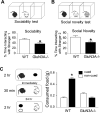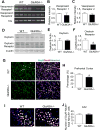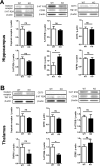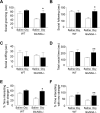Impaired social behaviors and minimized oxytocin signaling of the adult mice deficient in the N-methyl-d-aspartate receptor GluN3A subunit
- PMID: 29554474
- PMCID: PMC5955859
- DOI: 10.1016/j.expneurol.2018.02.015
Impaired social behaviors and minimized oxytocin signaling of the adult mice deficient in the N-methyl-d-aspartate receptor GluN3A subunit
Abstract
The N-methyl-d-aspartate receptor (NMDAR) has been implicated in the pathophysiology of neurological diseases, such as schizophrenia, autism spectrum disorders (ASD), and Alzheimer's disease (AD), whose unique clinical hallmark is a constellation of impaired social and/or cognitive behaviors. GluN3A (NR3A) is a unique inhibitory subunit in the NMDAR complex. The role of GluN3A in social behavioral activities is obscure. In this study, we sought to evaluate altered social activities in adult GluN3A knockout (KO) mice. GluN3A KO mice spent less time in reciprocal social interaction in the social interaction test compared to wild-type (WT) mice. A social approach test using a three-chamber system confirmed that mice lacking GluN3A had lower sociability and did not exhibit a preference for social novelty. GluN3A KO mice displayed abnormal food preference in the social transmission of food preference task and low social interaction activity in the five-trial social memory test, but without social memory deficits. Using a home cage monitoring system, we observed reduced social grooming behavior in GluN3A KO mice. Signaling genes that might mediate the altered social behaviors were examined in the prefrontal cortex, hippocampus, and thalamus. Among nine genes examined, the expression of the oxytocin receptor was significantly lower in the prefrontal cortex of GluN3A KO mice than that in WT mice. Oxytocin treatment rescued social activity deficits in GluN3A KO mice. These findings support a novel idea that a chronic state of moderate increases in NMDAR activities may lead to downregulation of the oxytocin signaling and impaired behavioral activities that are seen in psychiatric/neurodegenerative disorders.
Keywords: GluN3A; NR3A; Oxytocin signaling; Social behaviors.
Copyright © 2018 Elsevier Inc. All rights reserved.
Conflict of interest statement
Authors declare no conflict of interest associated with this investigation.
Figures







Similar articles
-
A neuroprotective role of the NMDA receptor subunit GluN3A (NR3A) in ischemic stroke of the adult mouse.Am J Physiol Cell Physiol. 2015 Apr 1;308(7):C570-7. doi: 10.1152/ajpcell.00353.2014. Epub 2015 Feb 4. Am J Physiol Cell Physiol. 2015. PMID: 25652449 Free PMC article.
-
Expression of the NMDA receptor subunit GluN3A (NR3A) in the olfactory system and its regulatory role on olfaction in the adult mouse.Brain Struct Funct. 2016 Jul;221(6):3259-73. doi: 10.1007/s00429-015-1099-3. Epub 2015 Sep 3. Brain Struct Funct. 2016. PMID: 26334321
-
Pathogenesis of sporadic Alzheimer's disease by deficiency of NMDA receptor subunit GluN3A.Alzheimers Dement. 2022 Feb;18(2):222-239. doi: 10.1002/alz.12398. Epub 2021 Jun 20. Alzheimers Dement. 2022. PMID: 34151525 Free PMC article.
-
Oxytocin receptor and Mecp2 308/Y knockout mice exhibit altered expression of autism-related social behaviors.Physiol Behav. 2012 Dec 5;107(5):641-8. doi: 10.1016/j.physbeh.2012.02.024. Epub 2012 Mar 3. Physiol Behav. 2012. PMID: 22406388 Free PMC article. Review.
-
GluN3A: an NMDA receptor subunit with exquisite properties and functions.Neural Plast. 2013;2013:145387. doi: 10.1155/2013/145387. Epub 2013 Dec 9. Neural Plast. 2013. PMID: 24386575 Free PMC article. Review.
Cited by
-
Maternal High-Fat diet During Pregnancy and Lactation Disrupts NMDA Receptor Expression and Spatial Memory in the Offspring.Mol Neurobiol. 2022 Sep;59(9):5695-5721. doi: 10.1007/s12035-022-02908-1. Epub 2022 Jul 1. Mol Neurobiol. 2022. PMID: 35773600
-
Neuropsychological Deficits Chronically Developed after Focal Ischemic Stroke and Beneficial Effects of Pharmacological Hypothermia in the Mouse.Aging Dis. 2020 Feb 1;11(1):1-16. doi: 10.14336/AD.2019.0507. eCollection 2020 Feb. Aging Dis. 2020. PMID: 32010477 Free PMC article.
-
Extrasynaptic NMDA receptors in acute and chronic excitotoxicity: implications for preventive treatments of ischemic stroke and late-onset Alzheimer's disease.Mol Neurodegener. 2023 Jul 3;18(1):43. doi: 10.1186/s13024-023-00636-1. Mol Neurodegener. 2023. PMID: 37400870 Free PMC article. Review.
-
DL-3-n-butylphthalide Increases Collateriogenesis and Functional Recovery after Focal Ischemic Stroke in Mice.Aging Dis. 2021 Oct 1;12(7):1835-1849. doi: 10.14336/AD.2020.1226. eCollection 2021 Oct. Aging Dis. 2021. PMID: 34631224 Free PMC article.
-
Social Interaction Test in Home Cage as a Novel and Ethological Measure of Social Behavior in Mice.Exp Neurobiol. 2019 Apr;28(2):247-260. doi: 10.5607/en.2019.28.2.247. Epub 2019 Apr 30. Exp Neurobiol. 2019. PMID: 31138992 Free PMC article.
References
-
- Akillioglu K, Binokay S, Kocahan S. The effect of neonatal N-methyl-D-aspartate receptor blockade on exploratory and anxiety-like behaviors in adult BALB/c and C57BL/6 mice. Behav Brain Res. 2012;233:157–161. - PubMed
-
- Al-Hallaq RA, Jarabek BR, Fu Z, Vicini S, Wolfe BB, Yasuda RP. Association of NR3A with the N-methyl-D-aspartate receptor NR1 and NR2 subunits. Mol Pharmacol. 2002;62:1119–1127. - PubMed
-
- Alvarez P, Wendelken L, Eichenbaum H. Hippocampal formation lesions impair performance in an odor-odor association task independently of spatial context. Neurobiol Learn Mem. 2002;78:470–476. - PubMed
-
- Anderson SW, Bechara A, Damasio H, Tranel D, Damasio AR. Impairment of social and moral behavior related to early damage in human prefrontal cortex. Nature Neurosci. 1999;2:1032–1037. - PubMed
Publication types
MeSH terms
Substances
Grants and funding
LinkOut - more resources
Full Text Sources
Other Literature Sources
Molecular Biology Databases
Research Materials

